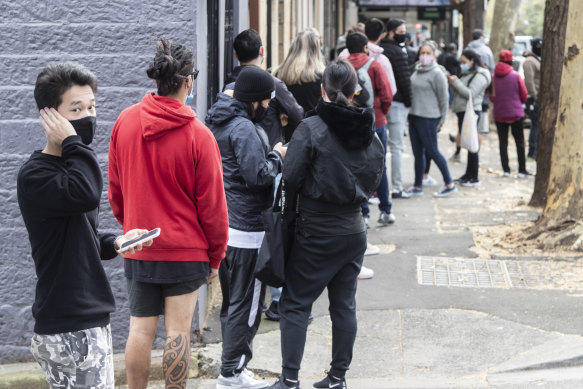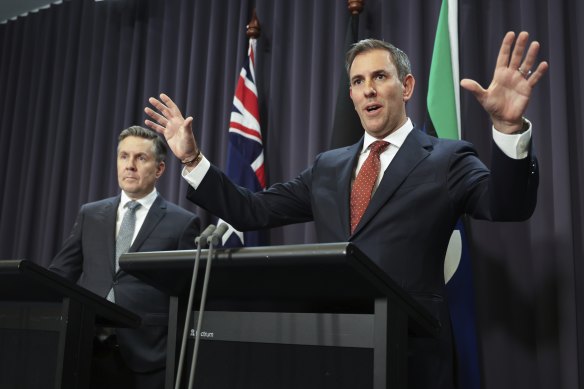This was published 9 months ago
Today’s inflation caused by yesterday’s COVID spending
By Shane Wright
An avalanche of government spending worth $343 billion aimed at protecting the economy through COVID-19, combined with extraordinary measures from the Reserve Bank, fuelled inflation and skill shortages that continue to plague the country while putting pressure on official interest rates.
A review of the government response to the pandemic shows inflation was up to 2 percentage points higher than it would otherwise have been because of the huge amount of government and central bank support, with rents and housing costs pushed up by the excessive stimulus.

People outside a Sydney Centrelink office in July 2021 after lockdowns hit the city. Credit: Louie Douvis
The review, whose panel included respected independent economist Angela Jackson, found most of the measures put in place in 2020 by the Morrison government, including its centrepiece $90 billion JobKeeper program, strengthened the country’s ability to deal with the health fallout from COVID-19.
That early success on the health front, the review found, minimised the pandemic’s economic impact and set the economy up well for recovery.
But ongoing and new stimulus measures pumped money into the economy just as inflationary pressures were starting to build.
The federal government’s total economic and health spending on the pandemic reached $343 billion, or 16.6 per cent of GDP. That does not include the Reserve Bank’s stimulus spending, which included $281 billion in government bonds, $188 billion in cheap loans to 92 commercial banks and taking the official cash rate to 0.1 per cent.
“With the benefit of hindsight, there was excessive fiscal and monetary policy stimulus provided throughout 2021 and 2022, especially in the construction sector. Combined with supply-side disruptions, this contributed to inflationary pressures coming out of the pandemic,” the review said.
Delays in the rollout of COVID-19 vaccines through 2021, on top of a failure to anticipate supply-side constraints that would be exposed when economies reopened, all had negative economic consequences.
“These included widespread labour and housing shortages and persistently high inflation, which, almost five years after the pandemic, continues to have repercussions for the Australian economy,” it found.
Decisions to exclude temporary migrants and foreign companies from JobKeeper, the report said, made skill shortages worse and added to inflationary pressures.
While the Reserve Bank has conducted reviews into its four largest stimulus programs, JobKeeper is the only government program that has been examined, and that was done by Treasury in 2023.
The report urged the government to review a string of stimulus measures, including the $35.9 billion cash-flow boost to businesses, the $11.5 billion in COVID-19 support payments, the $2.7 billion HomeBuilder program and the $38 billion early access to superannuation.
HomeBuilder, which started as a $700 million boost to the housing industry, fed directly into construction inflation, which reached 20.7 per cent in late 2022 and is still above 5 per cent.
“This has been a significant contributor to inflation coming out of the pandemic, and the program’s focus on renovations rather than new builds added to the general housing shortages,” it found.
In September 2020, the federal government announced plans for a “gas-fired” economic recovery, which included spending of almost $60 million on gas infrastructure projects.
But the report found this was an example of a “narrowly focused and poorly designed policy”, which would deliver only limited benefits to the manufacturing sector and job growth.
“These infrastructure stimulus measures aimed at supporting economic recovery were more focused on addressing demand rather than supply, demonstrating the government’s poor use of evidence and evaluation,” it said.
“We heard from many industries that they struggled to increase supply during the reopening due to uncertainty, ongoing restrictions and labour shortages.”

Treasurer Jim Chalmers, with Health Minister Mark Butler, says the COVID-19 report proves the inflationary impact of the Morrison government’s stimulus measures.Credit: Alex Ellinghausen
The review recommended the creation of an “economic toolkit” of policies that future governments could tap in future pandemics.
Treasurer Jim Chalmers would not be drawn on separate reviews of pandemic-era stimulus measures, instead focusing on the inflationary fallout from the programs.
He said while Labor had supported programs such as JobKeeper, the former government had failed to design them properly to avoid adding to inflation. Even in its budget in March 2022, it was increasing spending without finding offsetting cuts in expenditure.
“Overall, [the review] highlights poorly targeted policies, which contributed to Australia’s post-pandemic inflation, and the dramatic decline in real growth, which we have now started to turn around,” he said.
But Liberal leader Peter Dutton said Labor had wanted to spend more money during the pandemic.
“If their argument was inflation was a problem, their argument at the time was to fuel it
further, and this is something that Australians understand,” he said.
Cut through the noise of federal politics with news, views and expert analysis. Subscribers can sign up to our weekly Inside Politics newsletter.